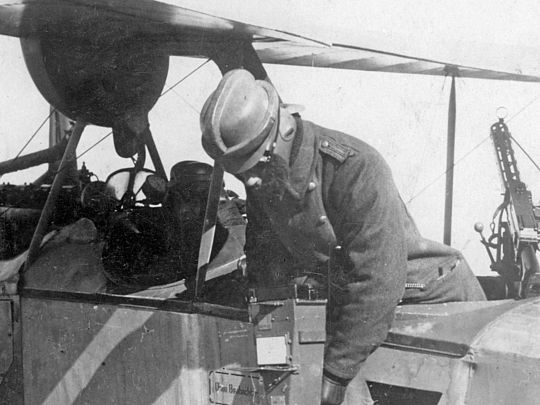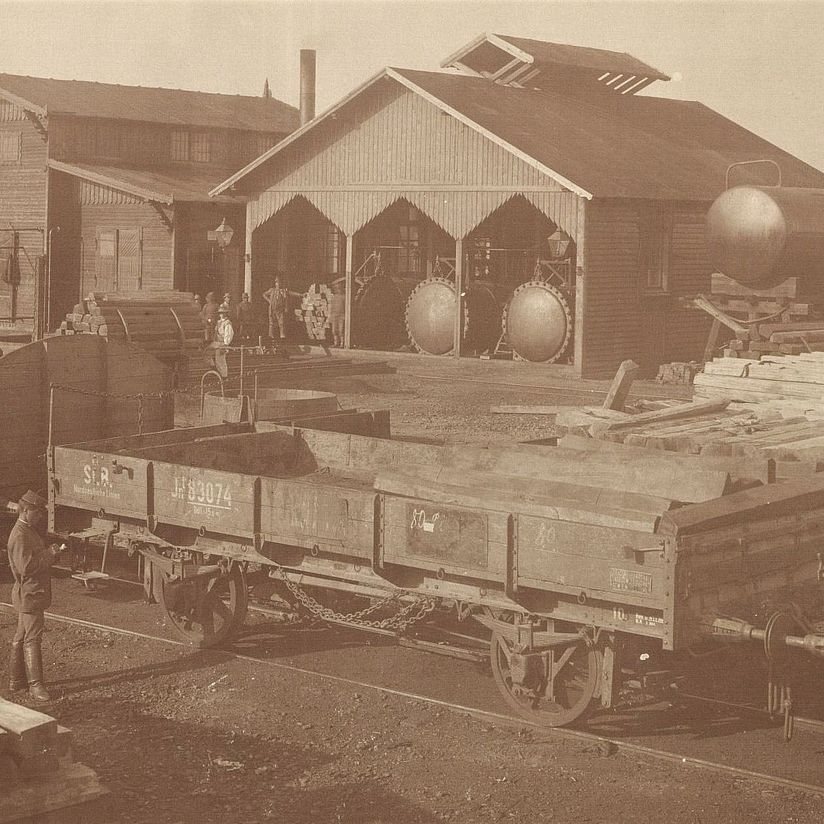

Wood impregnation facility of the Guido Rütgers KG, Chryplin (Galicia), ca. 1900 Photo: Steiermärkisches Landesarchiv, Firmenarchiv Guido Rütgers, Karton 518.
Environmental history
Cultures and Costs of Maintenance
Maintenance and repair are among the defining forms in which people interact with technology, and yet their historiography has clear gaps. With the help of material history, historical maintenance practices can be made visible, which were often accompanied by precarious working conditions and toxic materials. Their traces lead to current discussions about recycling, contaminated sites and environmental justice.
Content
Cultures and Costs of Maintenance. The Rise of Creosote and its Precarious Legacy
Funded by
Deutsche Forschungsgemeinschaft DFG
- Environmental history
Edited by
Dr. Martin Meiske
Wissenschaftlicher MitarbeiterDFG Projekt "Kulturen und Kosten der Wartung..."
Project description
In this project, the two more recent research fields of material history and maintenance and repair history are brought together. The analysis follows creosote, a coal tar oil, through various historical contexts from the end of the 19th century to the present day and illuminates dynamic interactions between technology, society, and the environment in Europe.
In a first step, the development from the by-product of the coal industry, which pollutes rivers, to the coveted wood impregnation agent for railway sleepers is to be reconstructed. If one then follows the creosote from the waste material to its new application as an impregnating material, a promising view on historical maintenance cultures opens up, which in large parts still has to be regarded as a research desideratum. The analysis is primarily aimed at the workers: inside the impregnation plants as well as the permanent way inspectors, platelayers, and track walkers in the railway maintenance service.
Impregnation institutes play a central role in the landfill registers that were created in the 1980s. The reconstruction of the conflicts surrounding their rehabilitation, which has been reflected in a growing number of citizens' initiatives in recent years, is a fruitful topic for interdisciplinary research at the interface between environmental history, the history of technology, and environmental sciences.
Finally, the history of the railway sleepers is also rich in changing forms of conversion, which should be examined in detail. In the railway foreman's creative use of old sleepers, the line between maintenance and innovation seems to be blurring. Until they were classified as a hazardous substance in the 1990s, impregnated old sleepers also found their way into public spaces and private households, where they were used, for example, as fence posts or raised plant beds.
Publications
Empire, Extraction, and Externalization. Wood Impregnation in Early 20th Century Bosnia and Herzegovina and its Precarious Legacy.” In Environmental histories of the Dinaric Karst, edited by Borna Fuerst-Bjeliš, Jelena Mrgić, Hrvoje Petrić, Matija Zorn, and Žiga Zwitter, forthcoming. Cham: Springer, 2023.
Clio-Guide: Technikgeschichte, in: Clio Guide – Ein Handbuch zu digitalen Ressourcen für die Geschichtswissenschaften, hrsg. von Silvia Daniel, Wilfried Enderle, Rüdiger Hohls, Thomas Meyer, Jens Prellwitz, Claudia Prinz, Annette Schuhmann, Silke Schwandt, 3. erw. und aktualisierte Aufl., Berlin 2023, https://doi.org/10.60693/e458-ba35
(mit Christian Zumbrägel) Holz im Zeitalter von Kohle und Stahl. Zur Persistenz und Wandelbarkeit eines Werkstoffes in der Hochindustrialisierung, in: Technikgeschichte 88 (2021) H. 3, S. 251–286, doi.org/10.5771/0040-117X-2021-3-251
Talks (Selection)
Ingolstadt, Jahrestagung der Gesellschaft für die Geschichte der Wissenschaften, der Medizin und der Technik (GWMT), 13.-15. September 2023: Sicherheit ist Beinarbeit. Polychrone Mobilitäten und envirotechnische Materialitäten im Bahnunterhaltungsdienst zu Beginn des 20. Jahrhunderts
Wien, Technisches Museum, 3rd Vienna Workshop on STEM Collections, Gender and Sexuality; “Diverse Infrastructures? Gender, Queer & the Foundations of Society”, 6-8 September 2023: Diverse Cultures of Maintenance. Railway Infrastructures and Gender in early 20th Century Germany
Bern, 12th Biennial European Society for Environmental History (ESEH) Conference, 22.-26. August 2023: Empire, Extraction, and Externalization. Wood Impregnation in Early 20th Century Bosnia and Herzegovina and its Precarious Legacy
Karlsruhe, Karlsruhe Institute of Technology (KIT) Institut für Technikzukünfte / Department für Geschichte, Kolloquium (Prof. Dr. Marcus Popplow), 13. July 2023: Kulturen und Kosten der Wartung. Der Aufstieg von Kreosot und sein prekäres Erbe
Berlin, Deutsches Technikmuseum, Abschluss-Workshop des DFG-Netzwerks Stoffgeschichte, 6./7. July 2023: Wartungsgeschichte als Stoffgeschichte. Ein Werkstattbericht zum Steinkohlenteeröl Kreosot
Wuppertal, Jahrestagung der Gesellschaft für Technikgeschichte (GTG) 12.-14. May 2023: Bahninfrastrukturen in Bewegung – Perspektiven aus der Stoff-, Umwelt- und Wartungsgeschichte
Hannover, Herrenhausen-Symposium, “Materiality and the History of Infrastructure,” 21 July 2022: Materialities of Maintenance: An Envirotechnical Analysis of Knowledge, Labor, and Toxicity in Railway Infrastructures
Lugano, Università della Svizzera italiana, Laboratorio di Storia delle Alpi (LabiSAlp), Workshop: “Communication Maintenance in Longue Durée,” 24/25 February 2022: The Hidden Cost of Maintenance. Reflections on the Persistence and Long-term effects of Railway Tie Impregnation for Environment and Society
Karlsruhe, Karlsruher Institut für Technologie (KIT), “Technikgeschichte über Mittag,” Online-Vortragsreihe der Gesellschaft für Technikgeschichte (GTG), 3 December 2021: Von Bahnmeistern, Streckenläufern und Rottenführern. Was heißt und zu welchem Ende studiert man Wartungsgeschichte?
Esch-sur-Alzette, University of Luxembourg, The Luxembourg Centre for Contemporary and Digital History (C²DH), Workshop: “Histories of Maintenance and Repair,” 3 September 2021: Cultures and Costs of Maintenance. The Rise of Creosote and its Precarious Legacy


![[Translate to English:] [Translate to English:]](/assets/_processed_/f/a/csm_Forschung_Projekt_RCC2_4949d83dc2.jpg)
